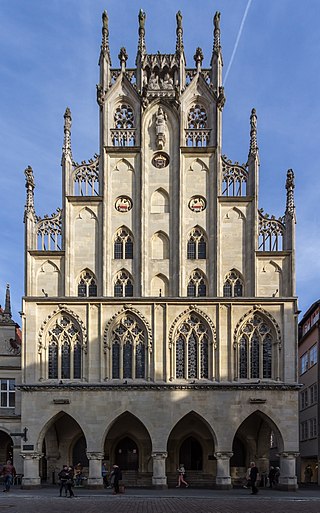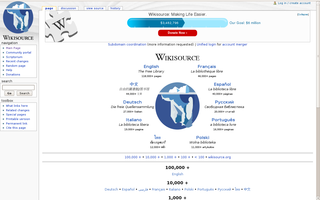
The Peace of Westphalia is the collective name for two peace treaties signed in October 1648 in the Westphalian cities of Osnabrück and Münster. They ended the Thirty Years' War (1618–1648) and brought peace to the Holy Roman Empire, closing a calamitous period of European history that killed approximately eight million people. Holy Roman Emperor Ferdinand III, the kingdoms of France and Sweden, and their respective allies among the princes of the Holy Roman Empire, participated in the treaties.

Matthias was Holy Roman Emperor from 1612 to 1619, Archduke of Austria from 1608 to 1619, King of Hungary and Croatia from 1608 to 1618 and King of Bohemia from 1611 to 1617. His personal motto was Concordia lumine maior.

Ferdinand III was Archduke of Austria from 1621, King of Hungary from 1625, King of Croatia and of Bohemia from 1627 and Holy Roman Emperor from 1637 to his death.

Ferdinand I was Emperor of Austria from March 1835 until his abdication in December 1848. He was also King of Hungary, Croatia and Bohemia, King of Lombardy–Venetia and holder of many other lesser titles. Due to his passive but well-intentioned character, he gained the sobriquet The Benign or The Benevolent.

Albrecht Wenzel Eusebius von Wallenstein, also von Waldstein, was a Bohemian military leader and statesman who fought on the Catholic side during the Thirty Years' War (1618–1648). His successful martial career made him one of the richest and most influential men in the Holy Roman Empire by the time of his death. Wallenstein became the supreme commander of the armies of the Imperial Army of Holy Roman Emperor Ferdinand II and was a major figure of the Thirty Years' War.

Wikisource is an online digital library of free-content textual sources on a wiki, operated by the Wikimedia Foundation. Wikisource is the name of the project as a whole and the name for each instance of that project ; multiple Wikisources make up the overall project of Wikisource. The project's aim is to host all forms of free text, in many languages, and translations. Originally conceived as an archive to store useful or important historical texts, it has expanded to become a general-content library. The project officially began on November 24, 2003, under the name Project Sourceberg, a play on the famous Project Gutenberg. The name Wikisource was adopted later that year and it received its own domain name.

Cardinal-Infante Ferdinand was a Spanish and Portuguese prince, Governor of the Spanish Netherlands, Cardinal of the Holy Catholic Church, Archduke of Austria, Archbishop of Toledo (1619–41), and a general during the Thirty Years' War, the Eighty Years' War, and the Franco-Spanish War. He is commonly considered the last great commander and strategist of the Spanish Empire, whose premature death in a decisive moment helped bring the end of Spain's hegemony in Europe. He is as well, one of few generals to be undefeated on the battlefield.

SS Kaiser Wilhelm II was a Norddeutscher Lloyd (NDL) Kaiser-class ocean liner. She was launched in 1902 in Stettin, Germany. In the First World War she was laid up in New York from 1914 until 1917, when the US Government seized her and renamed her USS Agamemnon. In 1919 she was decommissioned from the Navy and laid up. In 1927 she was transferred to the United States Army, who renamed her USAT Monticello. She was scrapped in 1940.

Gottfried "Götz" von Berlichingen, also known as Götz of the Iron Hand, was a German (Franconian) Imperial Knight (Reichsritter), mercenary and poet. He was born around 1480 into the noble family of Berlichingen in modern-day Baden-Württemberg. Götz bought Hornberg Castle (Neckarzimmern) in 1517, and lived there until his death in 1562.

The Italian War of 1551–1559 began when Henry II of France declared war against Holy Roman Emperor Charles V with the intent of recapturing parts of Italy and ensuring French, rather than Habsburg, domination of European affairs. The war ended following the signing of the Treaty of Cateau-Cambrésis between the monarchs of Spain, England and France in 1559. Historians have emphasized the importance of gunpowder technology, new styles of fortification to resist cannon fire, and the increased professionalization of the soldiers.

Princely abbeys and Imperial abbeys were religious establishments within the Holy Roman Empire which enjoyed the status of imperial immediacy (Reichsunmittelbarkeit) and therefore were answerable directly to the Emperor. The possession of imperial immediacy came with a unique form of territorial authority known as Landeshoheit, which carried with it nearly all the attributes of sovereignty.

Cambrésis is a former pagus, county and prince-bishopric of the medieval Holy Roman Empire that was annexed to the Kingdom of France in 1679. It is now regarded as one of the "natural regions" of France, and roughly equivalent to the Arrondissement of Cambrai in department Nord. The capital of Cambrésis was Cambrai. Originally ruled by a dynasty of counts, Cambrésis became a prince-bishopric in 1007, comparable to the Prince-Bishopric of Liège and the Prince-Bishopric of Utrecht. It encompassed the territory in which the bishop of Cambrai had secular authority.

Götz von Berlichingen is a successful 1773 drama by Johann Wolfgang von Goethe, based on the memoirs of the historical adventurer-poet Gottfried or Götz von Berlichingen. It first appeared in English in 1799 as Goetz of Berlichingen of the Iron Hand in a rather free version by Walter Scott.

The German Imperial Admiralty was an imperial naval authority in the German Empire. By order of Kaiser Wilhelm I the Northern German Federal Navy Department of the North German Confederation (1866–71), which had been formed from the Prussian Navy Department (Marineministerium), became on 1 January 1872 the German Imperial Admiralty. The head of the Admiralty administered the Imperial Navy under the authority of the imperial chancellor and the supreme command of the Emperor. It lasted until 1889, undergoing several reorganizations, but proved an impractical arrangement given the constant growth and the expansion of the Imperial Navy. Finally it was abolished in April 1889 and its duties divided among three new entities: German Imperial Naval High Command, the Imperial Naval Office (Reichsmarineamt), and the Imperial Naval Cabinet. The Imperial Naval High Command was, on 14 March 1899, replaced by the German Imperial Admiralty Staff, which simply transferred over most of the personnel of the Admiral Staff detachment of the former Naval High Command.
The Franco-Dutch treaty on Saint Martin border controls, sometimes shortened to the Franco-Dutch treaty and in full the Treaty between the Kingdom of the Netherlands and the French Republic on the control of persons entering Saint Martin through the airports, is a treaty between France and the Netherlands aimed at improving border controls at the two airports on the divided island of Saint Martin. The island is divided into French Saint-Martin and Dutch Sint Maarten.

The Army of the Holy Roman Empire was created in 1422 and came to an end when the Holy Roman Empire was dissolved in 1806 as a result of the Napoleonic Wars.

The Manifesto of the People of Brabant was a document made public at the start of the Brabant Revolution in 1789 proclaiming the end of the domination of the House of Austria over the Duchy of Brabant. It was first written in French and then printed in French and Dutch.

The Battle of Wevelinghoven or Battle of Grevenbroich was one of the final battles of the Thirty Years' War. It took place on 14 June 1648 between troops of Holy Roman Empire and of the victorious Hesse-Cassel. Several sources cite the Julian date of 4 June.
Circle troops were the contingents of soldiers that the Imperial Circles (Reichskreise) actually placed at the disposal of the Army of the Holy Roman Empire or Reichsarmee. Following the Imperial Defence Order (Reichsdefensionalordnung) all imperial circles in the empire were obliged to provide contingents of troops, although not all did so in the event. The Imperial Register (Reichsmatrikel) laid down how many troops the individual Imperial States had to make available to the Reichsarmee.
The Imperial Military Constitution was the collection of military laws of the Holy Roman Empire. Like the rest of the imperial constitution, it grew out of various laws and governed the establishment of military forces within the Empire. It was the basis for the establishment of the Army of the Holy Roman Empire, which was under the supreme command of the Emperor but was distinct from his Imperial Army, as it could only be deployed by the Imperial Diet. The last Imperial Defence Order (Reichsdefensionalordnung), entitled Reichsgutachten in puncto securitatis, of 13/23 May 1681, completed the military constitution of the Holy Roman Empire.

















